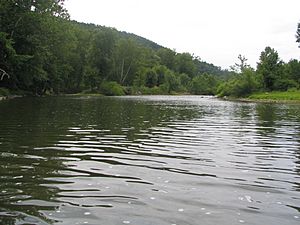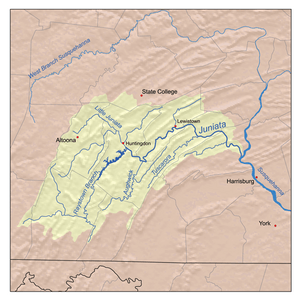Juniata River facts for kids
Quick facts for kids Juniata River |
|
|---|---|

Juniata River in Riddlesburg, PA
|
|

Juniata River watershed and tributaries
|
|
| Country | United States |
| State | Pennsylvania |
| Counties | Dauphin, Perry, Juniata, Mifflin, Huntingdon, Bedford, Somerset |
| Cities | Duncannon, Newport, Millerstown, Thompsontown, Port Royal, Mifflintown, Lewistown, Mount Union, Huntingdon |
| Physical characteristics | |
| Main source | Frankstown Branch Blair County, Pennsylvania, US |
| 2nd source | Little Juniata River Pennsylvania, US |
| River mouth | Susquehanna River Duncannon, Perry County, Dauphin County, Pennsylvania, US 330 ft (100 m) 40°24′05″N 77°00′48″W / 40.40139°N 77.01333°W |
| Length | 104 mi (167 km) |
| Discharge (location 2) |
|
| Basin features | |
| Basin size | 3,400 sq mi (8,800 km2) |
| Tributaries |
|
The Juniata River is a river in central Pennsylvania, United States. It is about 104 miles (167 km) (167 km) long. The Juniata River is a tributary of the larger Susquehanna River. It flows through beautiful mountain areas, often cutting through ridges in what are called water gaps.
Long ago, in the early 1700s, this river valley was a frontier area in Pennsylvania. It was a place where Native American groups and European settlers sometimes had conflicts, especially during the French and Indian War. The area that drains into the Juniata River, called its watershed, is about 3,400 square miles (8,800 km2) (8,800 km²). This is about one-eighth of the entire area that drains into the Susquehanna River. Most of the watershed, about two-thirds, is covered in forests. The Juniata River is the second largest river that flows into the Susquehanna River, after the West Branch Susquehanna.
Contents
Where the Juniata River Flows
The Juniata River starts in western Huntingdon County. It forms where two smaller rivers, the Frankstown Branch and the Little Juniata River, join together. This meeting point is between the towns of Alexandria and Petersburg.
The river then flows southeast through the town of Huntingdon. Near a small village called Ardenheim, the Raystown Branch joins the Juniata. The Raystown Branch is the longest of all the Juniata's smaller rivers.
The Juniata River continues southeast, cutting through a mountain ridge called Jacks Mountain. After passing this ridge, it receives Aughwick Creek from the south. Then, it flows northeast along the side of Jacks Mountain towards Lewistown. In Lewistown, it is joined by Kishacoquillas Creek and Jacks Creek.
From Lewistown, the river winds its way southeast. It receives Tuscarora Creek from the south and goes through another mountain ridge, the Tuscarora Mountain. As it reaches Millerstown in Perry County, three more creeks join it: Cocolamus Creek, Raccoon Creek, and Wildcat Run. Finally, the Juniata River also gets water from Buffalo Creek before it meets the Susquehanna River. This meeting point is near Duncannon, about 15 miles (24 km) (24 km) northwest of Harrisburg.
What's in a Name? The Juniata's Story
The name "Juniata" likely comes from an Iroquoian word, Onayutta. This word means "Standing Stone."
There used to be a very tall standing stone where the town of Huntingdon is today. People said it was about 14.5 feet (4.4 m) (4.4 meters) high. It had carvings that told the history of the local Juniata Tribe. This stone disappeared in 1754 when the tribe moved away. It's believed they took the stone with them.
Later, new settlers put up a second stone, but it was destroyed in 1897. Today, a small piece, about two feet (0.6 meters) long, of that second stone is kept in the museum at Juniata College.
A Look Back: History of the Juniata River Valley
The first people known to live in the Juniata River valley were the Onojutta-Haga Native Americans. Later, the Lenape tribe lived there.
In the 1700s, a treaty (an agreement) made by William Penn allowed European settlers to move into the land east of the Allegheny Ridge. This led to conflicts. In 1755–1756, the Lenape and Shawnee tribes, who were upset about losing their lands, attacked white settlements in the valley. Many settlers were affected by these raids.
One important event was the burning of Fort Granville in 1756, which was near what is now Lewistown. In response, Pennsylvania's governor, John Penn, sent soldiers led by Lt. Col. John Armstrong. They attacked and burned a Shawnee village called Kittanning in September 1756.
Canals and Railroads
In the 1800s, a canal system was built along the river. This was called the Juniata Division Canal. It was part of Pennsylvania's way to move goods and people, and it competed with the famous Erie Canal. The state later sold this canal to the Pennsylvania Railroad. The railroad stopped using the canal in 1889 after a big flood damaged it badly.
Even today, you can still see parts of the old canal locks and pieces of a dam about 1 mile (2 km) south of Millerstown. These are reminders of the river's past as a busy transportation route.
Fun on the River Today
Today, the Juniata River is a popular spot for outdoor activities. Many people enjoy canoeing and fly fishing here. The river's calm waters are perfect for catching fish like smallmouth bass and channel catfish. Another popular fish, the muskellunge, was brought to the river and is now a prized catch for anglers.
Efforts are being made to bring back the American shad, a fish that used to be common in the river but declined because of dams. Walleye are also found in the Juniata River.
The River in Art
The famous poet Galway Kinnell, who won a National Book Award and a Pulitzer Prize, wrote about the Juniata River in his book The Book of Nightmares (1971). One section was even titled "Dear Stranger, Extant in Memory by the Blue Juniata." This title refers to "The Blue Juniata," a well-known song from the 1800s.
River Environment
The Juniata River flows through several mountain ridges that run from southwest to northeast. These ridges are mostly made of sandstone, while the valleys are made of limestone.
Some of the smaller streams that flow into the Juniata, like Kishacoquillas Creek, have some pollution. However, the main part of the Juniata River is considered quite clean compared to other rivers in the region. The only large city in the river's watershed is Altoona. Because the slopes along much of the river are very steep, there hasn't been a lot of building or development right next to the river.
Images for kids
-
The Juniata River by Lewistown, Pennsylvania


